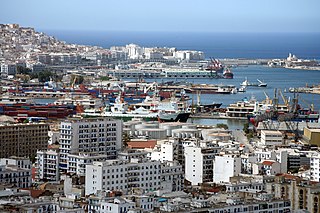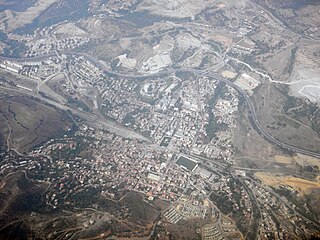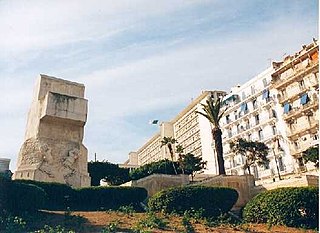
The Boulevard Mohamed-Khemisti, named after former foreign minister Mohamed Khemisti, is a major artery and public space in Algiers.

The Boulevard Mohamed-Khemisti, named after former foreign minister Mohamed Khemisti, is a major artery and public space in Algiers.
The boulevard runs upwards from east to west, starting near the seashore and ending at the esplanade in front of the Government Palace. It is divided into three sections: a northern boulevard, a middle section of plazas and gardens, and a southern boulevard. The middle section comprises, going from east to west: the place de la Grande Poste, a middle square, known as jardin de la Grande Poste; and on the slope, the Jardin de l'Horloge Fleurie, named after a floral clock, which houses the Memorial to the Liberation of Algeria.
The area is served by the Tafourah - Grande Poste station of the Algiers Metro.
The boulevard was created on the location of former fortifications built by the French colonial regime following the destruction of the eastern ramparts of the city at the level of the fort of Bab Azoun and the extension of the urbanization in the direction of the suburb of Agha. It was then named for Édouard Laferrière, a distinguished jurist who had died in mid-1901 shortly after the end of his service as French Governor-General of Algeria. The grounds were acquired in 1900 by a private company, the Compagnie foncière et immobilière de la Ville d'Alger, which developed it as they were made available by the military. The development included several public buildings, namely a customs administration building (completed in 1908), the Grande Poste d'Alger, and the Government Palace. [1]

Algiers is the capital and largest city of Algeria. The city's population at the 2008 census was 2,988,145 and in 2020 was estimated to be around 4,500,000. Algiers is located on the Mediterranean Sea and in the north-central portion of Algeria.

Mohamed Belouizdad is a quarter of Algiers, Algeria in Algiers Province. The quarter was formerly known as Belcourt during the French colonisation period. It was renamed as Hamma-El Annasser after Algerian independence, before the present name Belouizdad was adopted in 1992 in honour of the Algerian militant and nationalist Mohamed Belouizdad who lived in the quarter.

The Algiers Metro is a rapid transit system that serves Algiers, the capital of Algeria. Originally designed in the 1970s, it opened in 2011 after decades of delays due to financial difficulties and security issues. The Algiers Metro was the second metro system to open in Africa, after the Cairo Metro.

Bab Ezzouar is a suburb of the city of Algiers in northern Algeria. It is one of Algiers fastest growing municipalities and has seen many hotels and commercial malls being raised in the area. Bab Ezzouar is also the location of the University of Science and Technology of Houari Boumediene (USTHB), which is one of the most prominent technological universities in Algeria.

Thénia (الثنية), sometimes written as Thenia, with around 40,000 inhabitants, is the chief town in the daïra of the same name, in the wilaya of Boumerdès, in northern Algeria. Historically, the name is a contraction of Theniet Beni Aicha "the mountain pass of the sons of Aisha", the Arabic translation of the Kabyle Berber toponym Tizi n At Ɛica. The steep-sided pass, which is only about 800 metres wide at its narrowest point, is sometimes taken to mark the transition between Mitidja and Grande Kabylie.

The National Museum of Fine Arts in Algiers is one of the largest art museums in Africa. Opened to the public since 5 May 1930, it is located in the Hamma district, next to the Hamma test garden.
The following is a timeline of the history of the city of Algiers, Algeria.

Tafourah - Grande Poste is a transfer station serving the Line 1 of the Algiers Metro.

Ouled EL Bahdja, is a campaign among fans of USM Alger to restore the matchday atmosphere within Virage specifically, and Omar Hamadi Stadium more generally. It was established by a group of Algiers fans from Casbah in the nineties. Their songs are chanted by all the demonstrators in the four corners of the country and even elsewhere in the world. They refuse any public appearance and any media interview. They wish to remain anonymous, as they only sing for their club USM Alger. With the advent of Groupe SERPORT, the group suffered from legal prosecutions from people from the company's surroundings because of their criticism of the management method, and it increased because of the stadium issue, where Ouled EL Bahdja insisted on returning to its stronghold, the Omar Hamadi Stadium.
Mohamed Seghir Boushaki, was an Algerian Berber politician after the French conquest of Algeria.

Édouard Louis Julien-Laferrière was a French lawyer and authority in administrative law who held various senior administrative positions during the French Third Republic. He wrote a treatise on administrative law that defined the basis for modern French administrative law. He was appointed Governor-General of Algeria during a crisis in 1898, and established an elected advisory assembly with little real power. He encouraged southward expansion into the Sahara.

The architecture of Algeria encompasses a diverse history influenced by a number of internal and external forces, including the Roman Empire, Muslim conquest of the Maghreb, French colonization, and movements for Algerian independence.

The Algiers Central Post Office, is an office building for postal services located on Boulevard Mohamed-Khemisti, Alger Centre municipality in Algiers, Algeria. It was designed by architect Jules Voinot and Marius Toudoire and was constructed in 1910. It is Algeria's largest post office building, In 2015, the state turned it into a museum.

Brahim Boushaki, was an Algerian Scholar, Imam and Sufi Sheikh. He was born in the village of Soumâa near the town of Thénia 53 km east of Algiers. He was raised in a very spiritual environment within Zawiyet Sidi Boushaki with high Islamic values and ethics. He had great interpersonal skills and devoted his entire life in service of Islam and Algeria according to the Algerian Islamic reference.
Mohamed Aïchaoui was an Algerian journalist and militant in the nationalist movement against French Algeria. Aïchaoui wrote the Declaration of 1 November 1954, the National Liberation Front's first appeal to the Algerian people at the start of the Algerian War. After earlier imprisonment and torture, he died in a 1959 clash with the French army.

The People's National Assembly building is a public building in Algiers and home of Algeria's People's National Assembly. It was designed in 1934 and inaugurated in 1951 as a new city hall for the Greater Algiers, and repurposed following the country's independence in 1962.

The Government Palace, known before 1962 as Gouvernement général, is the office of the Prime Minister of Algeria and a major public building in Algiers. At the time of its inauguration in 1933, with a surface of 33,000 m2, it was the largest administrative building of the entire French state.

The Memorial to the Liberation of Algeria is a brutalist monument on Boulevard Mohamed-Khemisti in Algiers. It was designed in 1978 by Algerian visual artist M'hamed Issiakhem, as Algiers was preparing to host the 1978 All-Africa Games. The memorial incorporates an earlier sculpted group from the French colonial era, formerly known as the monument aux morts or Le Pavois, no longer visible but still extant beneath a concrete casing.
Yahia Boushaki, commonly known as Si Omar or simply as Boushaki, was a prominent revolutionary leader during the Algerian war of independence as a member of the Front de Libération Nationale that launched an armed revolt throughout Algeria and issued a proclamation calling for a sovereign Algerian state.

Yahia Boushaki Boulevard is a main boulevard in the city of Thénia of the Boumerdès Province within Algeria.